The Results
What . . . a . . . difference!
All of the deep, intense bass that I
had loved from before I installed the room treatments was back.
The room and corner loading, along
with reverberation that were in the room before, were actually distortion, but I had liked
the effect.
Now, I had the pleasure returned to
me, but it was accurate. Not loading. Not reverberation.
In fact, this turned out to be the
most significant change to my subwoofer setup that I have made in years.
It is really hard to put into words how much improvement this
represented.
The MIC-5
At CES 2006, Velodyne showed a new
product they call the MIC-5, or Bass Management Hub, priced at $799.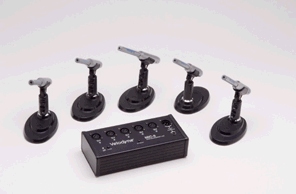
It consists of five microphones, with
XLR balanced output, five microphone stands, cables, and a junction box
that supplies the 48 volts that the microphones require.
You connect from one to all five
microphones to the junction box, connect the output of the box to the
SMS-1 or other EQ system, which can include such systems that are built
into receivers and processors, and acquire the EQ data.
The idea is that instead of getting
the EQ for just one listening position, you get it for an average over
several listening positions.
Shown below is the setup that I used,
with two microphones, one for each listening chair. The blue arrows
point out the two microphones, the yellow arrow points out the junction
box, and the black arrow indicates the SMS-1 in the front left subwoofer
position that the junction box output was connected to.
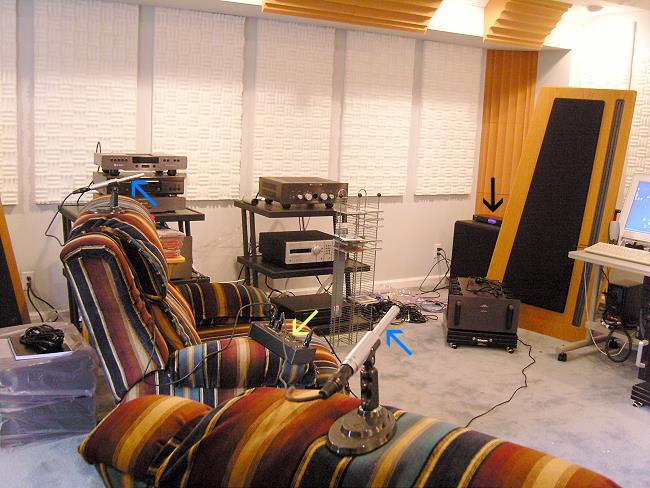
Here is a close-up photo of the
junction box. A 9 volt battery powers the box. You plug in the
microphones that you will be using, press the power button, and use the
Mic Select button to select how many microphones will be used. The blue
LEDs indicate that the two microphones are powered and ready to go.
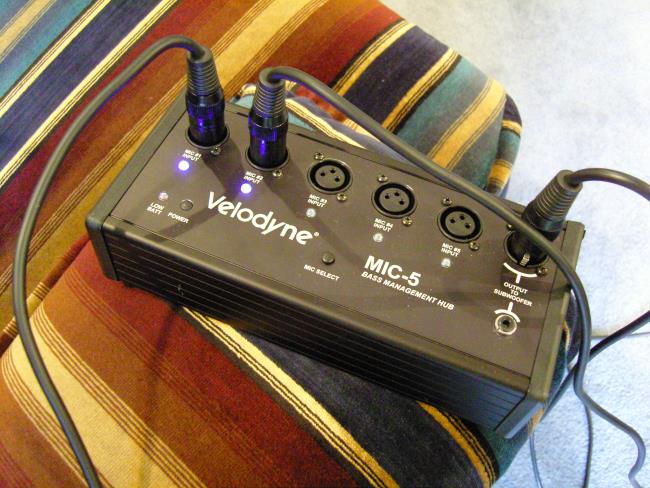
I think the MIC-5 will be a dynamite
component in the custom installer's arsenal of tools. If the customer
has one listening position, one microphone is used, if two, then two, if
five, then all five.
For my setup, I finally settled on
just one microphone, because I am the only listener 99% of the time.
However, the SMS-1 has memory settings for several different EQs (you
will need the TV connection so you can see the menu screen to do this,
by going into Setup). When you are the only one in the room,
sitting in your main chair, one EQ
memory setting. If you are sitting in a different spot, a second EQ
memory setting. When there are others, with you in the chair and them on
the couch, a third EQ memory setting. The MIC-5 lets you deal with the
third setting by using several microphones to set the optimal EQ for
people simultaneously in the room, in different places.
Be Realistic
Now don't go and try to EQ a large
home theater room
at 100 dB SPL down to 20 Hz with an 8" subwoofer. The SMS-1 is a fine
product, but it can't work miracles by defying laws of physics. If you
want high SPL all the way down to the limits of audibility (defined as
20 Hz for humans), use a big subwoofer, i.e., 15" or 18", such as
I have done here. With smaller subs, you will only be able to EQ down to
30 Hz or so, depending on the quality of the subwoofer and the power of
its amplifier.
One Last Thing
In the original SMS-1 review, the
amount of THD+N was not measured. In keeping with our procedures of
doing bench tests, I wanted to add the distortion measurements for the
SMS-1.
First, the sound card loop through
(output connected to input), using a 40 Hz sine wave (shown below).
THD+N is less than 0.002%.
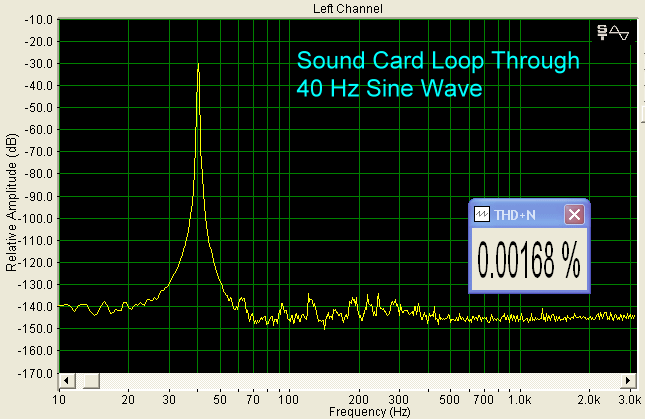
With the SMS-1 in the signal path,
THD+N increases to a little more than 0.05%, which is acceptable.
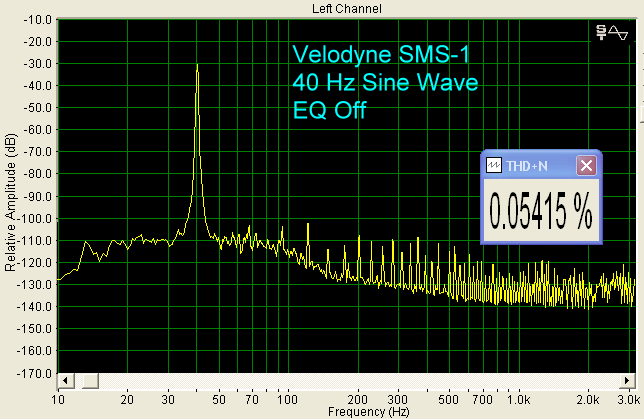
Perhaps most consumers who purchase
the SMS-1 may want to go ahead with connecting a TV and fine tune the EQ.
But, the point of this article is that you can get a significantly
improved bass by just activating the Self EQ. It really does perform
nicely.
Conclusions
My little experiment was a great
success. The use of the two SMS-1 outboard EQ units made so much
difference in my bass listening pleasure, I will never be without this
capability again.
The Self EQ worked very well, without
having to connect a TV and manually adjust any parametric EQ bands.
Whether you get the SMS-1, or a
Velodyne DD series subwoofer which has the SMS-1 circuitry built-in, or
one of the other outboard subwoofer EQ systems out there, you will
undoubtedly never want to be without it again either.
- John E. Johnson, Jr.
-